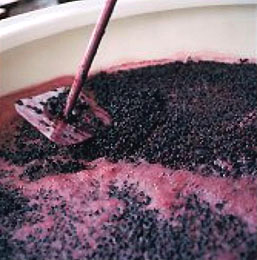 I just wanted to ask you if you think stirring or swirling a wine must when it starts to slow down before the first racking, because point zero hasn’t been reached yet, would that help or hurt anything as far as the wine is concerned, or should I just add more nutrient and not stir or swirl at all?
I just wanted to ask you if you think stirring or swirling a wine must when it starts to slow down before the first racking, because point zero hasn’t been reached yet, would that help or hurt anything as far as the wine is concerned, or should I just add more nutrient and not stir or swirl at all?
Thanks,
James
—–
Hello James,
The first thing that should be pointed out is that it is not unusual for a fermentation to slow as it reaches the end of fermentation. A lot of it has to do with the viability of the particular wine yeast strain you have chosen. Having said this, there is nothing about a slow wine fermentation that is inherently bad. The wine will turn out the same. Just think of it as the wine getting a little aging time in during the fermentation.
If you are making your wine from fresh fruit or fresh grapes, you should be stirring the wine once or twice a day while the pulp is the wine must, but it as nothing to do with the fermentation being slow or sluggish. The reason the stirring is done is to make sure that the wine fermentation does not form a dried floating cap of pulp. If this happens the oxygen is cut off from the wine yeast at a time with the it needs the oxygen the most.
Air or oxygen is what allows a wine yeast to grow into a colony large enough to ferment all the sugars in your wine must. If the air is limited, the colony will not grow successfully. The result is a slow wine fermentation, which by the way, is what you are experiencing right now.
Here’s what you can do for a slow wine fermentation…
If it has been going for at least 4 days in the primary, with the fruit pulp, I would go ahead and rack the wine into a secondary fermenter. Do it in a splashing manner so as to introduce oxygen into the wine must. This should help to invigorate the wine yeast.
Also, add a dose of yeast nutrient. If you already added yeast nutrient at the beginning of the fermentation, then go ahead and add another half-dose. This would be a 1/2 teaspoon per gallon. The yeast nutrient will add nitrogen to the wine must which can help the yeast in some of the same ways oxygen will.
Even though this is a slow wine fermentation, I would still put an air-lock on the secondary fermenter. The fermentation is coming towards a time when it will be susceptible to spoilage, so the air-lock is a necessity once racked. By the way, if you had the primary under air-lock, this can contribute to a sluggish wine fermentation with or without a dried cap.
Hope this information helps you out a little.
Best Wishes,
Ed Kraus
———————————————————————————————————
Ed Kraus is a 3rd generation home brewer/winemaker and has been an owner of E. C. Kraus since 1999. He has been helping individuals make better wine and beer for over 25 years.

morning, I wonder if you might have wine yeast list for the red star line like the one I got from ya’ll about the Lalvin brand. it would be appreciated greatly. thanks Frank Vance
F Vance, I’m not exactly sure what you mean by list. The link to a list of the different Red Star yeast we offer is this:
http://www.eckraus.com/red-star-yeast.html
Within the description on this page is a link to a yeast profile chart for these yeast, in case that was what you were referring to.